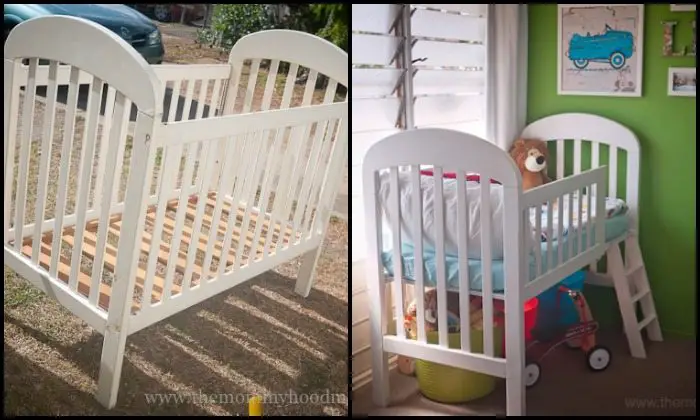On a regular basis, parents have to confront the daunting task of getting rid of growing children’s baby stuff. If we didn’t, we’d probably be buried alive, but letting go of outgrown toys and furniture can be both emotionally taxing and wasteful. Fortunately, an old crib toddler bed is a good way of bringing new life to old furniture.
Here’s a clever way to maximize the use of your child’s crib/cot as he or she transitions from being a baby to a toddler!
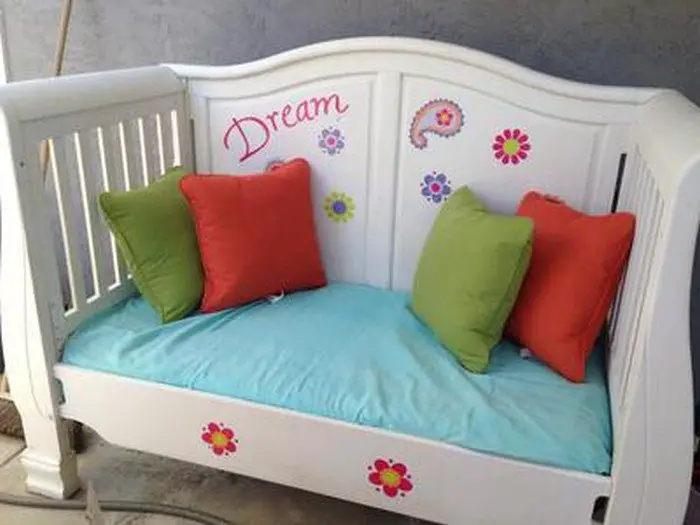
Instead of giving away or selling that cot (or before converting it into a totally different kind of furniture piece), you can turn it into a toddler bed. It’s easy to do – in fact, you may just have to turn it upside down – and it’s way less costly than getting a brand new bed for your youngster. And of course, it’s a bit of fun for everyone!
Do you know someone who could use this idea?
Contents
Building and Old Crib Toddler Bed
Materials
- Crib/Cot
- Wood Screws
- Pallet Wood Slats
- Wood Glue
- Metal Angle Brace
- Paint
Tools
- Cordless Drill
- Measuring Tape
- Spirit Level
- Miter Saw
- Router
- Sander
Instructions
Step 1: Planning and Preparation
- Assess the Crib: Check the crib’s condition. Ensure it’s sturdy and free of damage. Decide which side of the crib will be removed to create an opening for the toddler bed.
- Measure and Mark: Using the measuring tape, determine the height at which you want the bed’s side rail to be. Mark this on the crib’s side you plan to cut.
Step 2: Disassembling and Cutting
- Disassemble the Crib: Carefully disassemble the side of the crib you’re planning to convert. Keep all screws and parts in a safe place as you might need them for reassembly.
- Cut the Side Rail: If you’re shortening the side rail, use the miter saw to cut it down to the desired height.
Step 3: Preparing the Side Panel
- Trim Pallet Wood Slats: Measure and cut the pallet wood slats to fit the new side panel or guard rail. Use the miter saw for precise cuts.
- Sand the Edges: Smooth all edges and surfaces with the sander to prevent splinters.
Step 4: Assembling the Toddler Bed
- Attach the Side Panel: Align the trimmed pallet wood slats to the side of the crib you’re converting. Use wood glue to fix them in place temporarily.
- Drill and Screw: Once the glue is set, drill holes through the slats and into the crib’s frame. Secure them with wood screws.
- Install Metal Angle Braces: For additional support, install metal angle braces at the corners where the new side panel meets the crib’s frame. Use the cordless drill and wood screws for installation.
Step 5: Finishing Touches
- Fill Gaps and Sand: Use wood filler to fill any gaps or holes. Once dry, sand the filled areas until smooth.
- Paint: Apply a coat of paint to the newly converted toddler bed. Choose a non-toxic paint that’s safe for children. Let it dry according to the manufacturer’s instructions.
Step 6: Final Assembly and Safety Check
- Reassemble and Tighten: Put the crib back together with its new toddler bed configuration. Tighten all screws and ensure the bed is stable.
- Safety Inspection: Use the spirit level to ensure the bed is perfectly level. Check for any sharp edges or loose screws. Make sure the mattress fits snugly within the frame.
Step 7: Ready for Use
Once you’ve completed these steps, your old crib is now a safe and comfortable toddler bed. Introduce it to your child and enjoy this new chapter in their growth.
Click on any image to start the lightbox display. Use your Esc key to close the lightbox.![]()


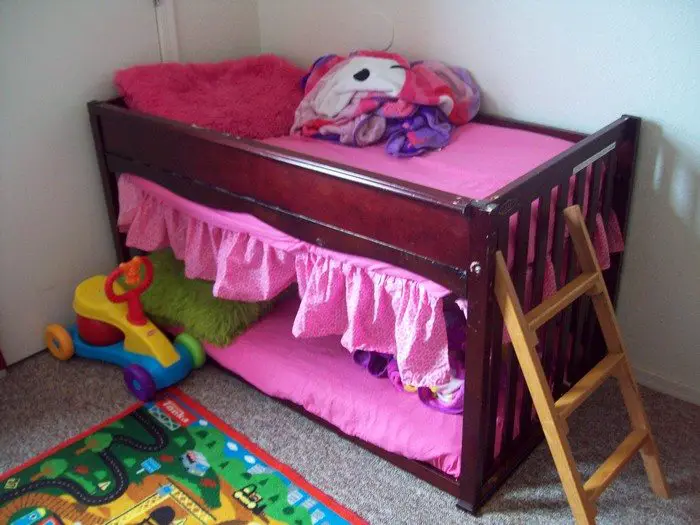

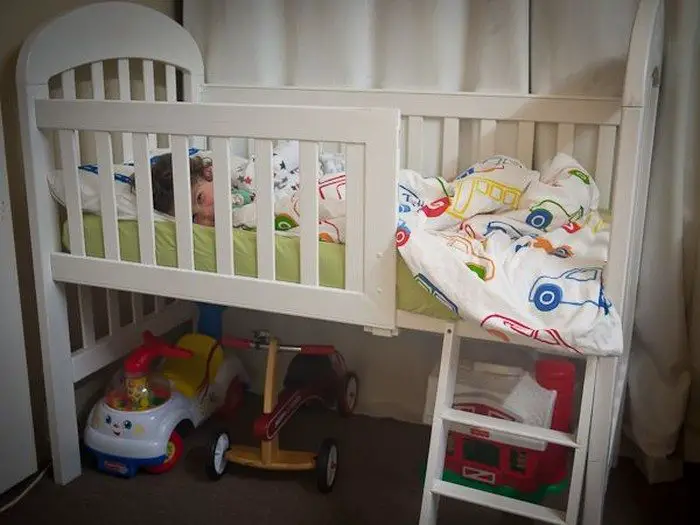

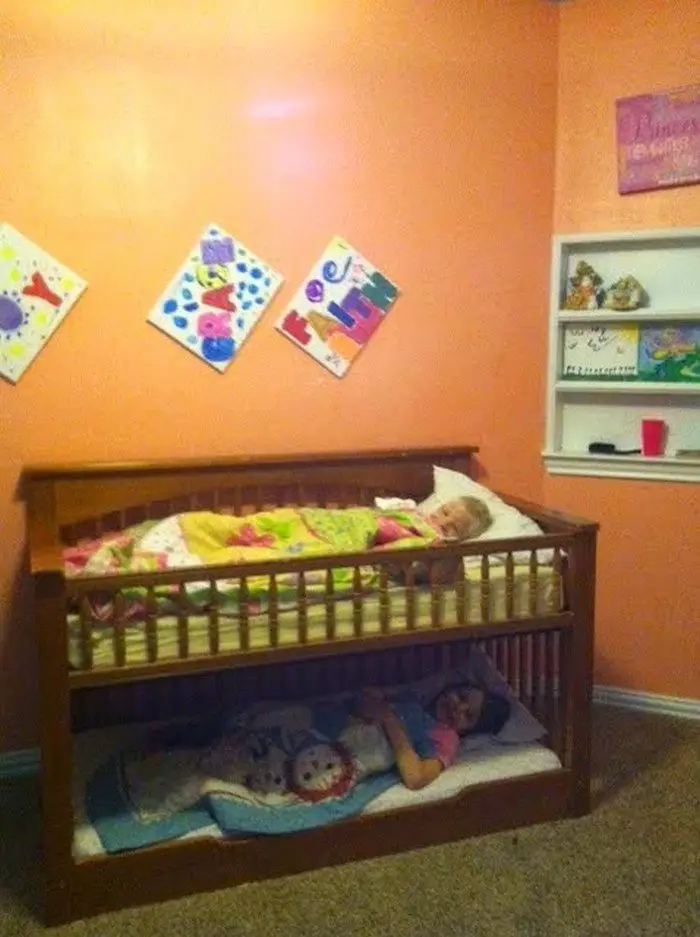

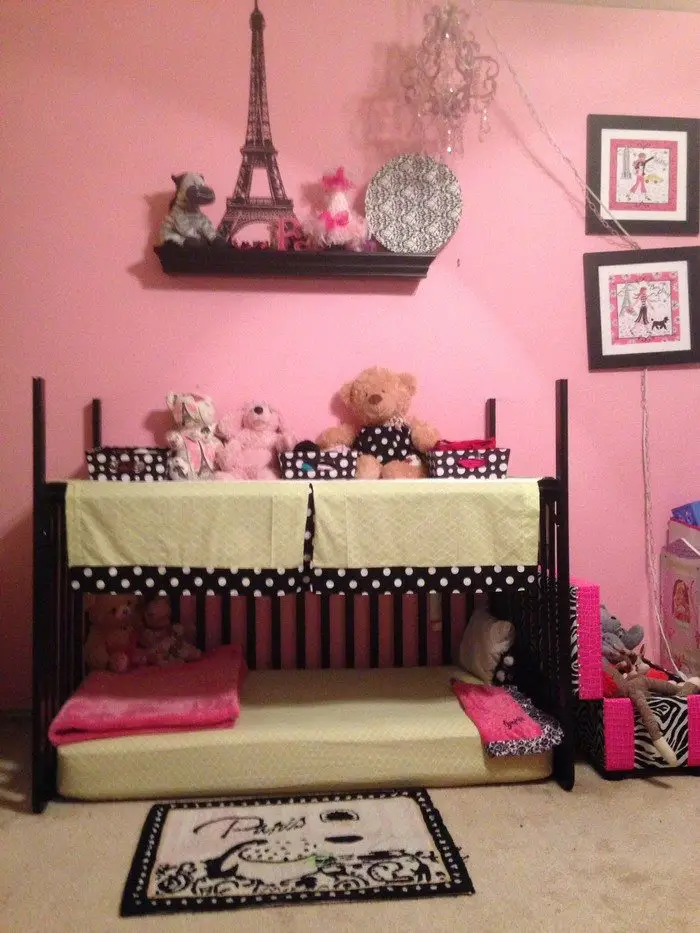
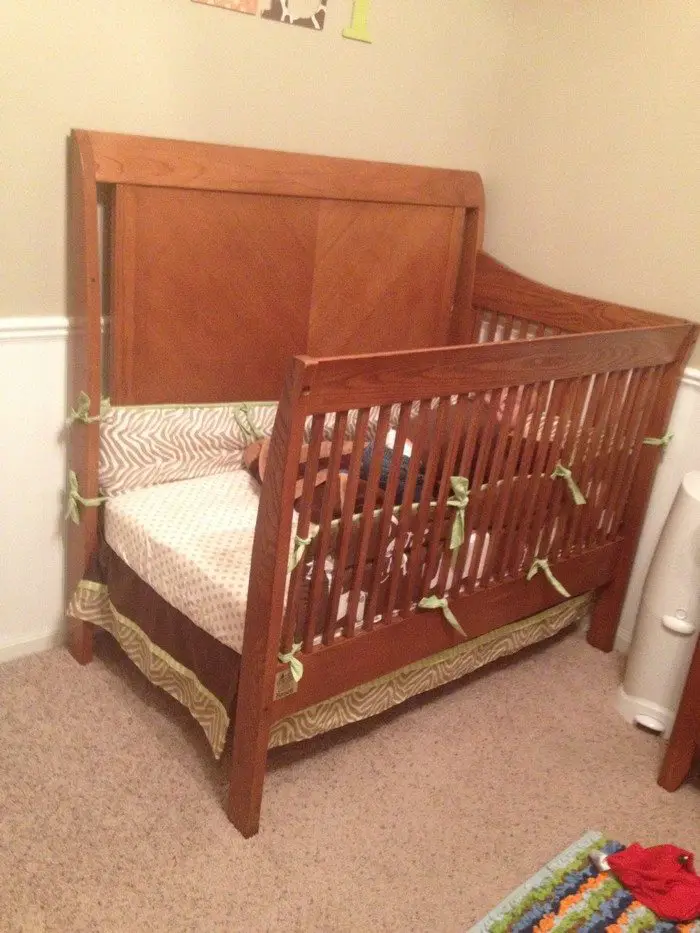
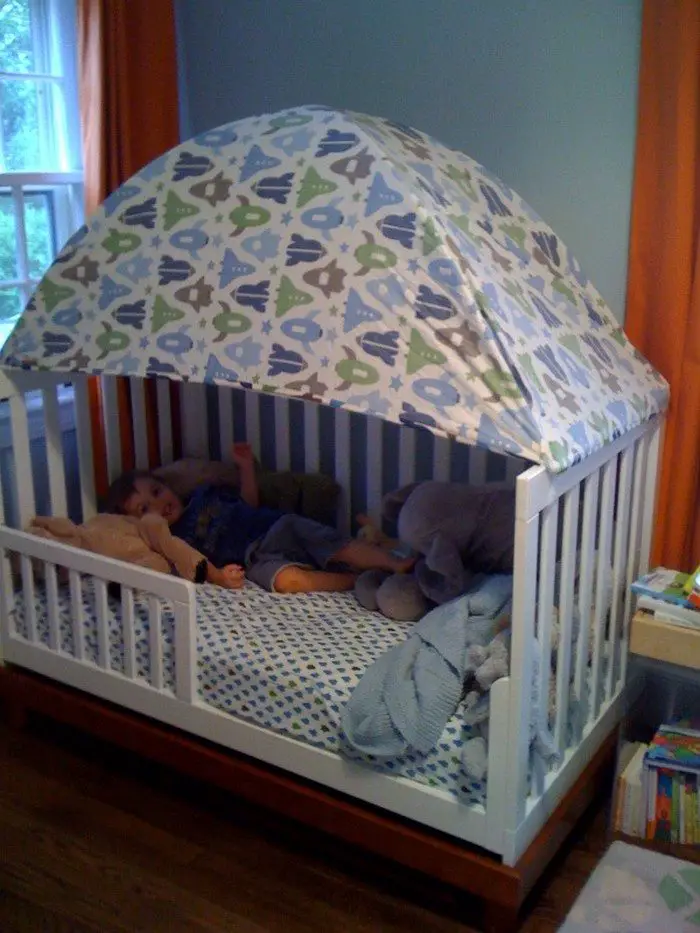
Safety Considerations When Converting a Crib into a Toddler Bed
Transforming an old crib into a toddler bed is a sustainable and cost-effective way to adapt to your growing child’s needs. However, ensuring the safety of the newly converted bed is paramount.
Below are crucial safety considerations to remember during and after the conversion process of an old crib toddler bed.
Assess the Crib’s Condition
Before starting the conversion, thoroughly inspect the old crib toddler bed for any signs of wear and tear. Check for loose screws, cracked wood, or peeling paint, which could pose risks to your child. Ensure the crib’s structure is still robust and capable of supporting the conversion.
Secure and Stable Construction
When converting the old crib toddler bed, ensure all new and existing components are securely attached. Use high-quality wood screws to reinforce the structure. After conversion, shake the bed gently to test its stability. It should not wobble or creak under light pressure.
Smooth Edges and Non-toxic Paint
The safety of an old crib toddler bed also depends on the absence of sharp edges and the use of non-toxic materials. Sand down any rough areas to prevent splinters. Choose child-safe, non-toxic paint for the bed, as toddlers often put their mouths on surfaces. This precaution prevents exposure to harmful chemicals.
Appropriate Guardrail Height
For an old crib toddler bed, installing a guardrail on the open side is crucial to prevent falls. The guardrail should be high enough to prevent your toddler from climbing over it, typically at least 16 inches (40 cm) from the mattress top. Ensure there are no wide gaps where a child’s head, torso, or limbs could get trapped.
Mattress Fit and Bedding
Ensure the mattress fits snugly within the frame of the old crib toddler bed. Gaps between the mattress and the bed frame pose a risk of entrapment. Additionally, opt for fitted sheets and avoid using soft bedding, pillows, and large stuffed animals, as these can increase the risk of suffocation.
Continuous Supervision and Maintenance
Even after converting the old crib toddler bed, regular checks are necessary to maintain its safety. Periodically tighten any loosened screws and inspect for any new damage or wear. Continuous supervision ensures the bed remains a safe sleeping environment for your toddler.
Adequate Ventilation
Ensure the mattress selected for the old crib toddler bed allows for proper air circulation. Adequate ventilation in a mattress can help regulate your toddler’s body temperature throughout the night, contributing to safer, more comfortable sleep.
Compliance with Safety Standards
Verify that the old crib, when converted into a toddler bed, complies with the latest safety standards and regulations. This includes checking for any recalls or safety warnings issued for the crib model. Adhering to updated safety standards can prevent unforeseen hazards.
Regular Inspection of Wear and Tear
Frequently inspect the old crib toddler bed for signs of wear and tear, especially around joints and points of conversion. Look for splintering wood, rusting metal, or loosening components. Regular maintenance is key to ensuring the bed remains a safe environment.
Eliminate Entrapment Risks
In addition to ensuring no gaps between the mattress and bed frame, pay close attention to the spacing of any slats or bars on the bed. The spaces should be narrow enough to prevent a child’s head, neck, or limbs from becoming trapped.
Optimal Height and Accessibility
Adjust the height of the old crib toddler bed so that it is appropriate for your toddler’s size and mobility. The bed should be low enough to the ground that the child can safely get in and out without assistance, minimizing the risk of falls.
Use of Guardrails
Even with one side of the crib removed for the conversion, consider adding guardrails to the other three sides of the bed. This can prevent your child from rolling out of bed while sleeping. Ensure the guardrails are securely attached and tall enough to be effective.
Monitor Accessories and Bed Placement
Keep the area around the old crib toddler bed clear of any cords, strings, or small objects that could pose a strangulation or choking hazard. Additionally, position the bed away from windows, heaters, wall-mounted decorations, and furniture that a child might climb on to ensure a safe sleeping environment.
Following these safety considerations, you can confidently convert an old crib into a toddler bed. This provides a sense of continuity and comfort for your child and reflects a mindful approach to parenting and environmental stewardship.
Choosing the Right Mattress for Your Toddler’s Bed
Selecting the right mattress for your toddler’s bed is crucial for their comfort and safety, especially when transitioning from a crib to a toddler bed. The process becomes even more significant when converting an old crib into a toddler bed, ensuring that the new sleeping environment supports your child’s growing body.
Here’s how to choose the perfect mattress for your old crib toddler bed.
Size and Fit
The old crib toddler bed mattress must fit snugly within the bed frame. A tight fit prevents any dangerous gaps a toddler could slip into. Measure the interior dimensions of the converted crib carefully. Most cribs are designed to fit a standard crib mattress, but it’s always best to double-check.
Firmness
A firm mattress is essential for toddler beds, including those converted from old cribs. A firm surface supports the toddler’s developing bones and helps reduce the risk of suffocation, which softer mattresses can pose. While the mattress should be firm, it should also be comfortable enough to promote restful sleep.
Material
When choosing a mattress for an old crib toddler bed, consider hypoallergenic materials that resist mold, mildew, and dust mites. Foam and innerspring mattresses are popular choices, but ensure they are made from non-toxic materials. Organic mattresses can be a great option, offering chemical-free comfort.
Waterproof and Washable
Toddlers are prone to accidents, so a waterproof mattress or cover is a must-have for an old crib toddler bed. Look for a mattress with a washable cover to make clean-ups easier and maintain a hygienic sleeping environment for your child.
Safety Standards
Ensure any mattress you consider for your old crib toddler bed meets current safety standards. Certifications like CertiPUR-US for foam mattresses indicate that the product is free from harmful chemicals and meets strict health and environmental guidelines.
Durability
Considering the investment in a mattress for an old crib toddler bed, choose one built to last. A durable mattress supports your toddler through their preschool years and offers the possibility of use for future siblings.
By selecting the right mattress for an old crib toddler bed, you ensure your toddler’s transition to a bigger bed is comfortable, safe, and conducive to a good night’s sleep. This careful consideration aids in their development and ensures peace of mind for you as a parent.
Conclusion
Transforming an old crib into a toddler bed is a creative and sustainable solution for accommodating your growing child’s needs. It ensures the continuation of using a cherished piece while prioritizing safety and comfort. This process not only saves resources but also adds a personal touch to your child’s transition to independence.
If you liked this, you will also like the “Twelve ways to repurpose that cot!“…

